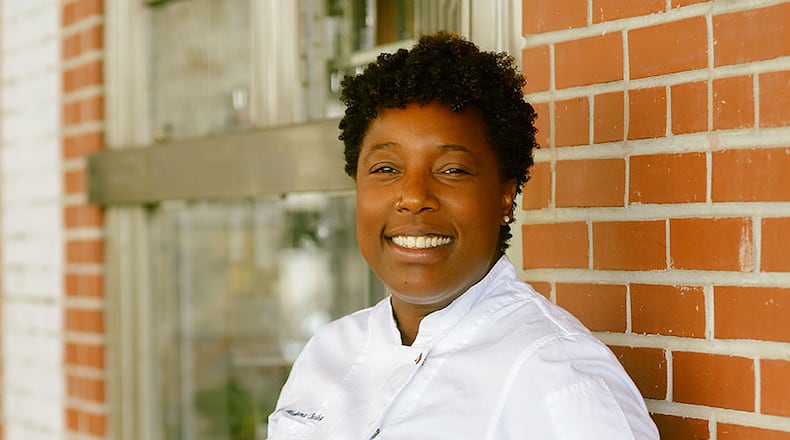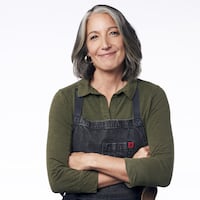Female, chef, restaurateur. Each of those titles would be correct in association with Mashama Bailey, but the James Beard award-winning executive chef and partner of celebrated Savannah fine-dining restaurant the Grey has also emerged as one who brings a “little bit of Black Power” to the plate.
Bailey, 46, divulges this side of her personality in the recently published dual memoir “Black, White, and the Grey” (Lorena Jones Books, $28) that she co-authored with her business partner John O. Morisano.
Credit: Handout
Credit: Handout
“Black Power is not about exercising power over White people,” she writes. “It is not about stereotypes of Black culture or validating those things. It is about understanding that we are in a subjugated position, shining a light on that fact and helping each other by creating and sharing opportunities for self-determination.”
Born in 1974, Bailey didn’t have much to say in the matter when, at age 5, ties to Georgia led her parents to pack up their belongings in the Bronx and move the family south to Savannah, where she lived until she turned 11.
She didn’t embark on a formal culinary journey until she was let go from a post-college job at a homeless shelter. Getting fired, she writes, “forced me to make a decision about my life path, one that I thought was too late for me to make.”
Culinary school led to a restaurant externship, followed by a gig as a personal chef, then a gastro-driven exploratory time in France. There were then stints at New York restaurants, including what would prove to be four formative years at Gabrielle Hamilton’s heralded Prune.
“Up until I worked for Gabrielle, I was more interested in technique and trying to impress the chef,” Bailey said in a recent phone interview. Prior to Prune, she was “not really focused on my own career and what I wanted to get out of it.”
It was a pivotal moment when Hamilton introduced the sous chef to Morisano, who sought a Black female chef as a partner in a project to convert an abandoned, once segregated, Greyhound station in Savannah into a restaurant.
Credit: Chia Chong
Credit: Chia Chong
In “Black, White, and the Grey,” Bailey recounts pondering whether “opening a restaurant in Savannah with a White man was something that I wanted to seriously pursue.” And she was concerned about Morisano’s sensitivity regarding the history of oppression and exploitation of Blacks. Through this unlikely partnership, “he was putting himself in a position from which he could not begin to understand the historical and cultural ramifications of the endeavor,” she writes.
Ultimately, Bailey said yes.
“Black chefs in the South were not being recognized or celebrated, not like their counterparts,” she writes. “I wanted to be part of this Southern food movement. I wanted to reimagine the Southern Black experience through food — cooking the same traditional foods, but with different techniques.”
The Grey opened in late 2014. It took a few years before Bailey’s singular culinary voice emerged. In the book, she describes the approach as using “the African diaspora as a guide and our local farmers as our resources to help us unlock what Southern food means and to guide how we cook it.” Food at the Grey is “a representation of this region and the larger community, especially the African-American heritage inherent in it all.”
Her voice struck a chord. Bailey garnered a James Beard nomination as best chef in the Southeast region in 2018. A year later, she came back with the medal.
Credit: Chia Chong
Credit: Chia Chong
“What kind of chef am I?” she asks introspectively when featured in a 2019 episode of the hit Netflix series “Chef’s Table.” The creative talent behind exquisite foie and grits is the same brain who delights adults at the Grey with an ice pop known as a Thrill, a throwback to Kool-Aid frozen in a Dixie cup that Bailey enjoyed in her childhood during hot Savannah summers.
Her evolution as a chef doesn’t stop. “It evolves all the time,” she said. “Today, I think I am looking for more refinedness.”
Besides her own growth, Bailey continues to push for a more diverse, inclusive and equitable workplace, beginning with the one that she and Morisano oversee.
“Bringing Black people along and amplifying their voices to help shape and mold our culture would be very important,” she told Morisano when they first agreed to team up.
The partnership hasn’t always been equal, they admit in the memoir. The relationship is one of continued learning in a quest for mutual trust and understanding. The manuscript, formatted as a back-and-forth conversation, was not completed until the pair finally put work life aside and holed up for six weeks in a Parisian apartment to hash out “the story of an unexpected friendship and a beloved restaurant,” as the subtitle reads.
Bailey hopes that the book results in “more conversation” and other books “that go deeper.” “We just brushed the surface because it was our comfort level at the time. Hopefully, this book will relax people to be vulnerable,” she said.
Credit: Adam Kuehl
Credit: Adam Kuehl
In Morisano’s view, the book is “just an account of two people telling their relationship that is potentially a microcosm of others to view. If you build trust, share an opinion, you make progress.”
As another sign of progress, Bailey and Morisano are expanding their brand, opening the Grey Diner Bar and the Grey Market inside a hotel in downtown Austin, Texas, later this year. “We think we have something to add to the language of food there,” said Bailey. “I think Black folks’ story is going to be different in Austin than Savannah. It will be a fresh lens to look through.”
BLACK HISTORY MONTH
Throughout February, we’ll spotlight different African American pioneers ― through new stories and our archive collection ― in our Living and Metro sections Monday through Sunday. Go to ajc.com/news/martin-luther-king-jr/ for more subscriber exclusives on people, places and organizations that have changed the world, and to see videos on the African American pioneers featured here each day.
About the Author
The Latest
Featured







